Physical Address
304 North Cardinal St.
Dorchester Center, MA 02124
This normal process within the transitional zone of postpubertal women results in the replacement of endocervical surface and glandular epithelium by squamous epithelium, resulting in a cephalad migration of the squamocolumnar junction. The replacement may sometimes be incomplete with persistence of endocervical glands on the ectocervix. Extensive glandular epithelium on the ectocervix is occasionally associated with vaginal adenosis.
Florid squamous metaplasia within endocervical glands or endocervical polyps can simulate well-differentiated ISqCC. Features favoring the former include a superficial location; nests of cells with smooth contours consistent with replaced endocervical glands; bland nuclear features; no stromal response; residual mucinous epithelial cells, gland lumina, or luminal mucin; and absence of dysplasia in the adjacent squamous epithelium.
Immature squamous metaplasia is characterized by less maturation resulting in an appearance that can be misconstrued as SIL and therefore is considered in Chapter 5 in the differential diagnosis of SILs.
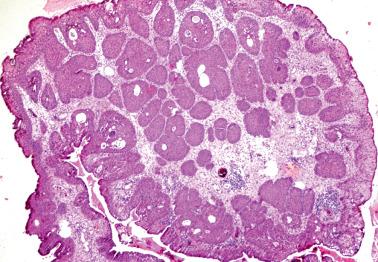
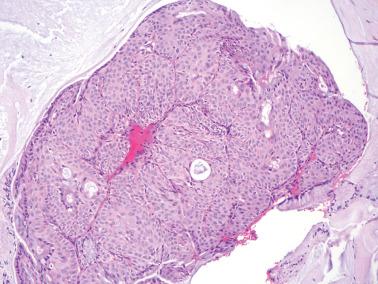
This process (TCM) is typically an incidental microscopic finding in postmenopausal and occasionally premenopausal women and prepubertal females. TCM may result in an abnormal Pap smear, but the distinctive appearance of the cells differentiates them from SILs and typical atrophy.
TCM in postmenopausal women and women receiving androgen therapy for gender reassignment suggests hypoestrinism as a cause in some cases. In one case, TCM was associated with the adrenogenital syndrome and cervical ectopic prostatic tissue.
TCM usually involves the ectocervical epithelium, less commonly the surface or glandular epithelium of the endocervix and transformation zone. Occasionally, invagination of the involved epithelium results in isolated stromal nests of transitional cells.
Multiple layers of cells with pale, uniform, oval to spindle nuclei are usually oriented vertically in the deeper layers, and horizontally (with a streaming or whorled pattern) superficially. Perinuclear halos may be present. A superficial layer of ‘umbrella’ cells is a rare finding.
The N:C ratio is usually high and the nuclei have finely stippled chromatin, inconspicuous nucleoli, and occasional longitudinal nuclear grooves; mitotic figures are rare to absent. Rarely, the cells have superimposed dysplastic changes.
TCM is CK13+/CK17+/CK18+/CK20− whereas urothelial transitional cell epithelium is CK13+/CK17+/CK18+/CK20+.
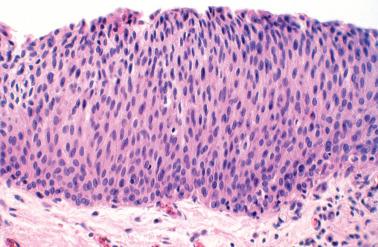
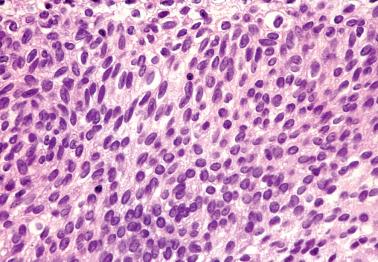
HSIL. The lack of normal maturation can suggest an HSIL, but that diagnosis is excluded by bland nuclear features, absent or rare mitotic figures, and usually negative p16 staining. However, rare otherwise typical HPV− TCMs in older women with atrophic squamous epithelium enigmatically show block positivity for p16.
Atrophy. The numerous layers of cells and nuclear grooves distinguish transitional cell metaplasia from atrophic squamous epithelium, although the cells of the latter occasionally appear transitional.
Tubal metaplasia (TM) refers to the replacement of the endocervical columnar epithelium by tubal-type epithelium. Less commonly, the epithelium is intermediate in appearance between that of tubal and endometrioid epithelium (tuboendometrioid metaplasia, TEM), or rarely, it is purely endometrioid (endometrioid metaplasia, EM).
These metaplasias are usually an incidental microscopic finding, but occasionally may account for abnormal glandular cells in a Pap smear.
TM has been found in ~20% of cone biopsy and ~60% of hysterectomy specimens. TEM was found in ~25% of post-cone biopsy hysterectomy specimens in one series, suggesting that it is a reparative response in some cases.
Vang et al. reported an unusual form of TM associated with in utero exposure to diethylstilbestrol (DES) (see below).
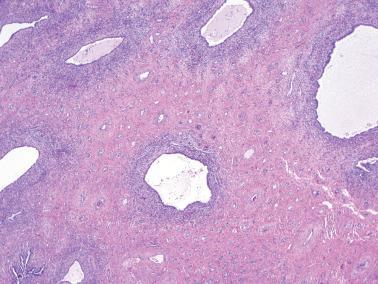
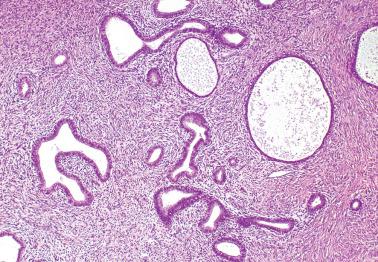
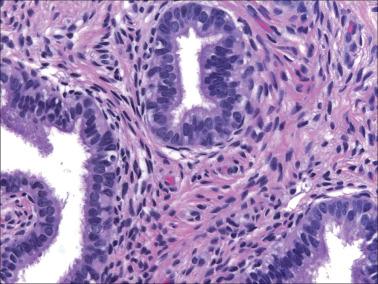
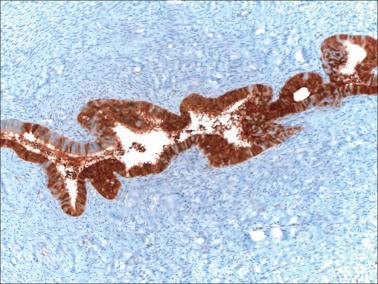
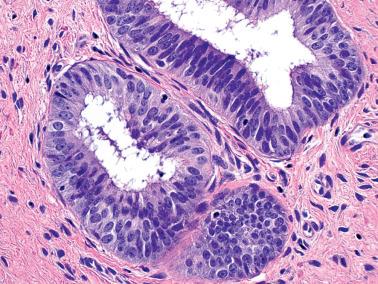
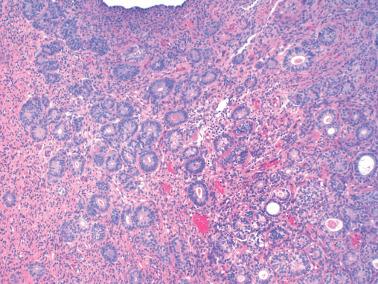
In TM, the endocervical surface or glandular epithelium is replaced by a single layer of admixed ciliated, nonciliated, and peg cells in varying combinations although ciliated cells often dominate. TEM is similar to TM except for the presence of fewer ciliated cells. The nonciliated columnar cells of TM and TEM may have apical snouts that may represent an early manifestation of TM.
The glands involved by TM and TEM are usually similar to normal endocervical glands in size, shape, and distribution. Mild periglandular hypercellularity is common and may be diagnostically helpful. Unusual findings in TM and TEM include variability in gland size and shape, cystic dilatation, focal crowding, a deep location (see Deep Glands and Cysts ), and prominent periglandular stromal hypercellularity or edema.
Vang et al. reported cases of TM associated with in utero DES exposure that had a haphazard pseudoinfiltrative pattern and involvement of the resection margins. In one case there was moderate atypia and mitotic activity.
TM and TEM are distinguished from adenocarcinoma in situ (AIS) by a usual admixture of cell types, a typical absence of atypia, an absence or paucity of mitotic figures, and absence of apoptosis, and from invasive adenocarcinoma by the absence of an infiltrative pattern. TM and TEM can occasionally be p16+ but without the strong diffuse staining of AIS.
Rarely TM may merge with atypical TM and ciliated AIS ( Chapter 6 ).
Typical endometriosis of the cervix (see below). In contrast to TEM or EM, endometrial-type periglandular stroma is usually present in endometriosis, but may be sparse and partly obscured by inflammatory cells. Distinction between TM and atrophic endometriosis (with no or minimal stroma) may be impossible in some cases but is of no clinical importance, as is also the occasional difficult distinction of the cellular stroma of TM from endometriotic stroma.
Ciliated AIS ( Chapter 6 ). This lesion is distinguished from TM and TEM by the presence of malignant nuclear features.
Low-grade endocervical glandular dysplasia (EGD). Subtle or incompletely developed cases of TM may be diagnosed as low-grade EGD, a diagnosis we avoid (see Chapter 6 ).
Mesonephric hyperplasia (see corresponding heading) with endometrioid-like glands. The usual deep location of the process, admixture of more typical mesonephric tubules with their colloid-like luminal secretions, and GATA3 positivity facilitate the diagnosis.
Cervical endometriosis may be superficial (mucosal) or deep. The superficial form is often localized to areas of prior biopsy or cautery, suggesting implantation of endometrium or trauma-induced metaplasia. Deep cervical endometriosis is usually an extension of cul-de-sac involvement associated with typical pelvic endometriosis.
Superficial endometriosis is usually an incidental microscopic finding, but occasionally it can cause a thickened, granular, or hemorrhagic mucosa, or result in abnormal glandular cells in a Pap smear. The lesion is almost always confined to the superficial one-third of the cervical wall, most often just beneath the surface epithelium.
The endometriotic glands are typically well spaced and round to oval but occasionally may show irregularity in size and shape and crowding. They most commonly resemble the glands of a proliferative or weakly proliferative endometrium, including the presence of occasional mitotic figures, but occasionally have a secretory appearance.
Endometriotic stromal cells are usually obvious although they may be sparse and/or obscured by edema, hemorrhage, and inflammation.
The presence of the characteristic small arterioles and extravasated erythrocytes can facilitate the recognition of the stromal component in such cases.
Special stains may help but are rarely needed. Reticulin and trichrome stains reveal that endometriotic stroma typically has dense reticulin and sparse collagen with the opposite findings in normal endocervical stroma. Endometriotic stromal cells are CD10+/CD34−, whereas endocervical stromal cells exhibit the opposite findings, although some periglandular endocervical stromal cells may stain for CD10.
If endometriosis is not recognized microscopically, reactive atypia and/or mitotic activity in the endometriotic glands and their occasional p16 positivity may suggest endocervical glandular dysplasia or AIS.
An absence of both marked nuclear atypia and numerous apoptotic bodies and recognition of the endometriotic nature of the stromal cells facilitate the diagnosis.
Additionally, the p16 staining is usually more focal than in AIS and the epithelial cells of endometriotic glands are strongly bcl2+, whereas those of AIS are bcl2−.
Stromal endometriosis, an uncommon variant of endometriosis, is characterized by an exclusive component of endometriotic stroma.
Usually well-delineated foci within the superficial cervical stroma are composed of endometrial stromal cells, small blood vessels, and extravasated erythrocytes.
In some cases, the appearance may cause concern for Kaposi's sarcoma. Although we are not aware of any cervical cases of Kaposi's, this diagnosis would be favored in the presence of a fascicular arrangement of mitotically active spindle cells with hyaline globules and an HSV8+/CD10−/ER− immunoprofile.
The differential diagnosis might rarely include a mucosal deposit by endometrial stromal sarcoma, but cervical involvement by the latter would usually be associated with an obvious infiltrative process.
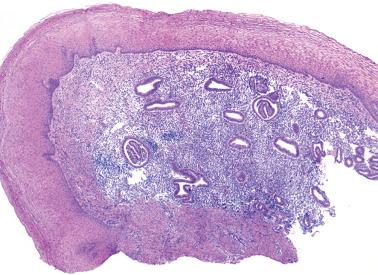
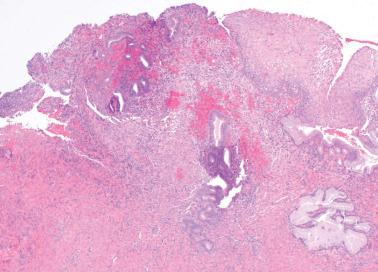
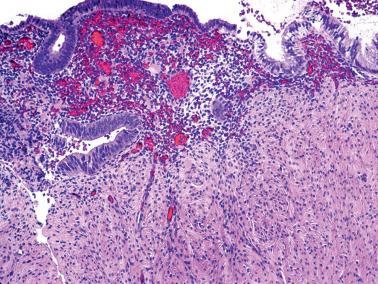
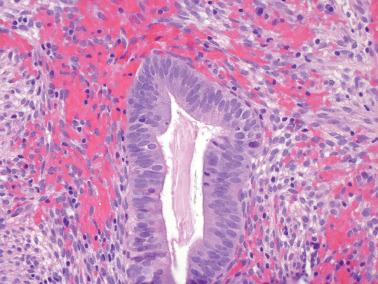
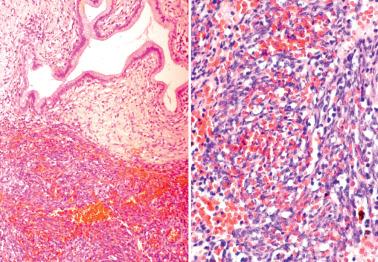
This term refers to the rare occurrence of ectopic benign-appearing endocervical-type glands ( Chapter 19 ). In cervical cases, the outer cervical wall and paracervical connective tissue are usually involved. One case was associated with chronic pelvic pain following cesarean section.
Variability in gland size and shape, an infiltrative pattern, a stromal response to extravasated mucin, and the deep location of the glands may suggest minimal deviation adenocarcinoma (MDA) ( Chapter 6 ).
Features distinguishing endocervicosis from MDA include absence of a mucosal-based adenocarcinoma merging with the deep glands, absence of overtly dysplastic or malignant glands, and the occasional admixture of other benign müllerian-type glands, endometriotic stroma, or both.
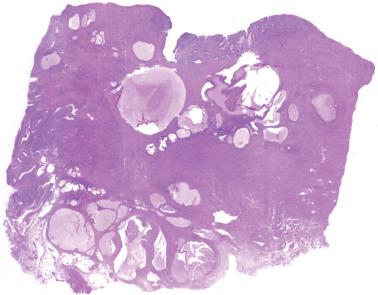
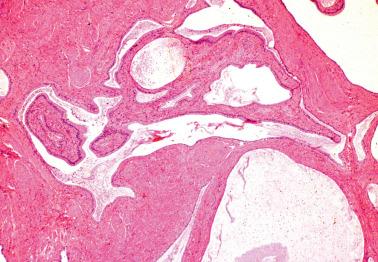
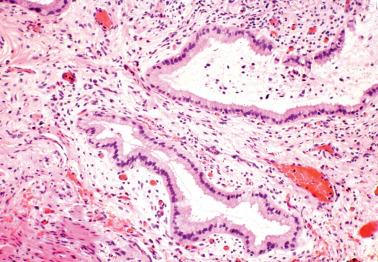
Although uterine involvement is typically confined to the uterine serosa ( Chapter 19 ), endosalpingiosis rarely can involve the wall of the cervix and lower corpus, sometimes resulting in a clinically evident mass and on gross examination a thickened wall with multiple cysts.
Extensive cervical mural endosalpingiosis has been misinterpreted as MDA. The absence of a mucosal-based tumor, the admixture of cell types including ciliated cells, and the absence of more than mild nuclear atypicality facilitate the diagnosis.
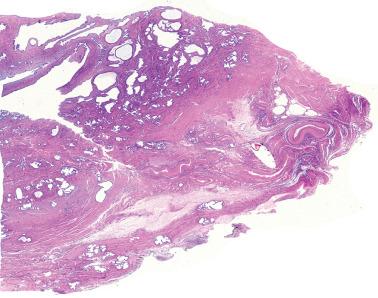

Otherwise typical endocervical glands and their cystic counterparts (nabothian cysts) uncommonly extend into the outer third of the cervical wall. Deep glands are an incidental microscopic finding, but deep nabothian cysts may result in a striking gross appearance.
In contrast to the glands of adenocarcinoma, deep glands and cysts are usually widely spaced, relatively uniform in size and shape, and lack cytologic atypia and a periglandular stromal response.
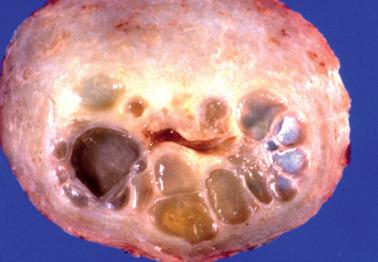
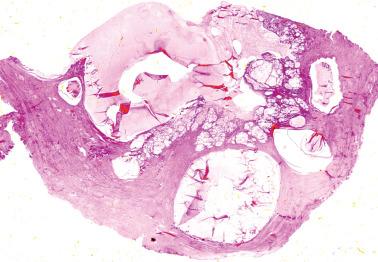
Intestinal metaplasia is characterized by the presence of goblet and occasionally argentaffin cells within endocervical glands. It is rare in a pure (nondysplastic) form, as it is usually associated with nuclear features of AIS (intestinal-type AIS) ( Chapter 6 ).
Simple gastric (pyloric) metaplasia is a subtle finding in which isolated endocervical glands are lined by columnar cells with abundant, pale, eosinophilic, HIK1083+ cytoplasm (Mikami and McCluggage). Similar glands are occasionally seen in type A tunnel clusters (see corresponding heading) and may be found adjacent to gastric-type adenocarcinomas ( Chapter 6 ).
Oxyphilic metaplasia is an incidental microscopic finding of no clinical significance. The change is invariably focal, involving only a few glands or even a single gland.
The normal endocervical glandular epithelium is replaced by a single layer of large cells with eosinophilic cytoplasm and variably sized, hyperchromatic nuclei but without mitoses.
A lack of cellular stratification, apoptosis, and mitoses facilitates distinction from endocervical glandular dysplasia and AIS. These lesions also usually lack abundant oxyphilic cytoplasm.
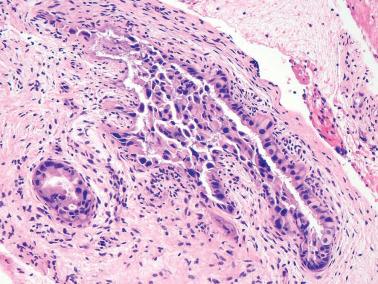
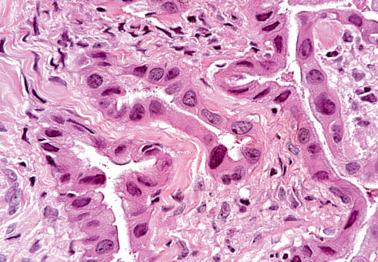
Almost 40 cervical examples of a finding variably labelled ectopic prostatic tissue or ectopic Skene's glands have been reported. The women were of reproductive or postmenopausal age and otherwise normal except for one who had adrenogenital syndrome, elevated testosterone levels, and cervicovaginal transitional cell metaplasia, and two female-to-male transgender patients who were receiving testosterone.
The ectopic tissue, which is typically ectocervical, is usually an incidental microscopic finding, but rarely forms a mural mass comprised of typical prostatic glandular tissue including basal cells, secretory cells, and in some cases squamous metaplasia. Squamous elements may predominate, potentially obscuring the glandular component. Rarely, sebaceous glands and basaloid formations resembling hair follicles may also be found.
The glandular cells (but not the squamous cells) are typically PSA+ and/or PAP+ although occasionally both markers are absent. The basal cells are 34βE12+. The glands and squamous elements are typically AR+, whereas only the squamous elements are ER+.
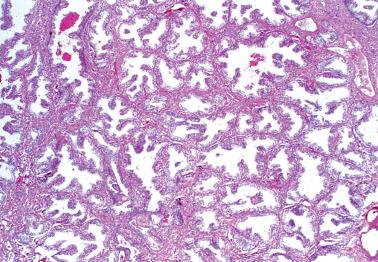
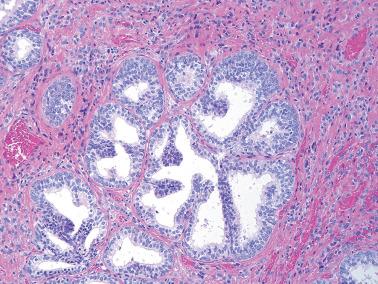
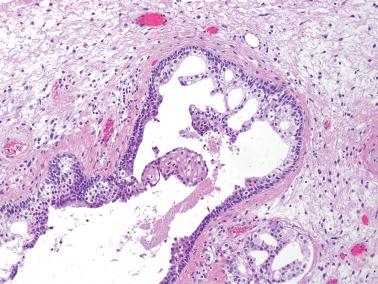
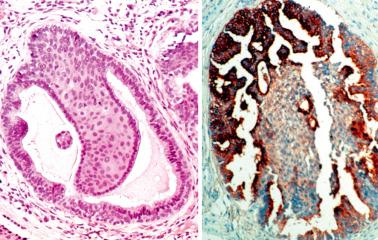
Doldan et al. found mature adipose tissue in 17% of cone/LEEP specimens, usually within the deep cervical stroma around large vessels, but occasionally in the superficial stroma around endocervical glands. The differential diagnosis includes pseudolipomatosis ( Chapter 7 ).
Rarely, sebaceous and sweat glands, hair follicles, glia, and bone (including dermoid cyst-like structures) are incidental microscopic findings in the cervix, including endocervical polyps. Some such cases represent retained fetal tissues, as confirmed by DNA genotyping in a case of cervical glial tissue (see Chapter 7 ).
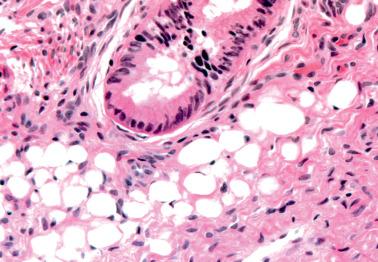
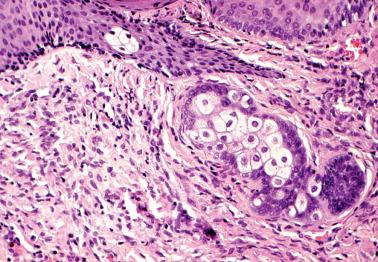
Tunnel clusters (TCs) were first described by Fluhmann, who recognized a non-cystic type (type A) and the much more common cystic type (type B). The appearance of TCs and their strong association with multiparity suggest that they may represent an involution of pregnancy-induced endocervical glandular hyperplasia.
TCs are almost always an incidental pathologic finding that occurs in 10% of adult women. Rare cases may be associated with a mucoid discharge. Cystic TCs are grossly visible in a minority of cases.
TCs are multiple in 80% of cases, and are occasionally confluent. They are usually superficial but occasionally extend deeply and lack a stromal response.
Each TC is a rounded aggregate of oval, round or irregular closely packed glands of varying size that are lined by a single layer of flattened to cuboidal cells when cystic, or cuboidal to columnar cells when noncystic.
The nuclear features are usually bland and mitotic figures absent. Focal mild to moderate nuclear atypia and rare mitoses are occasionally present, particularly in noncystic TCs.
Some gland clusters suggestive of noncystic TCs, in contrast to their cystic counterparts and normal endocervical glands, may contain neutral mucin (red staining with PAS/AB) and stain with HIK1083 and MUC6 (pyloric gland mucin), thus favoring lobular endocervical glandular hyperplasia (see corresponding heading).
A lobular arrangement and absence of overtly dysplastic glands, an infiltrative pattern, and a stromal response facilitate distinction from adenocarcinoma, including the minimal deviation variant.
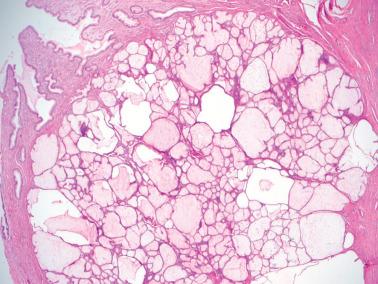
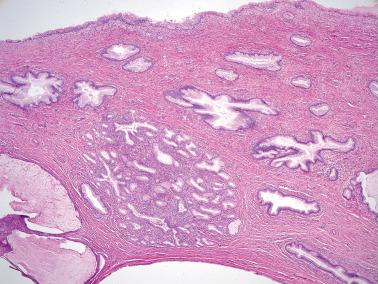


Microglandular hyperplasia (MGH) is a distinctive proliferation of endocervical glands, often related to estrogen and progesterone stimulation (oral contraceptives, pregnancy), but can also occur in those receiving only estrogen, only progesterone, or in the absence of hormonal intake.
MGH is a common incidental microscopic finding, usually in the reproductive age group; <5% of cases are postmenopausal. The patients are usually asymptomatic, or rarely experience vaginal bleeding and/or discharge.
There is usually no grossly visible lesion, but MGH may appear as an erosion or polyp, or even a lesion suspicious for carcinoma. MGH is most commonly encountered as a microscopic finding, often within an otherwise typical endocervical polyp.
Microscopically, closely packed glands of varying shapes range from small to larger and cystic. The lumens often contain inspissated mucin and inflammatory cells. A typically scanty stroma is usually infiltrated with acute and chronic inflammatory cells.
The glands are lined by low columnar, cuboidal, or flattened cells, frequently with subnuclear vacuoles, and small regular nuclei with inconspicuous nucleoli and, in most cases, absent to rare mitotic figures. Focal squamous metaplasia and/or reserve cell hyperplasia are common.
Unusual microscopic features can increase concern for adenocarcinoma, but awareness of these features, merging or admixture with typical MGH, and a paucity of mitotic figures are helpful findings.
Solid, reticular, and trabecular patterns.
An edematous, myxoid, or hyalinized stroma, sometimes containing irregularly disposed epithelial aggregates, resulting in a pseudoinfiltrative pattern.
Unusual cell types including spindle-shaped cells, polygonal cells with abundant eosinophilic cytoplasm, and signet-ring-like cells.
Mild to moderate nuclear atypia.
Mitotic figures. Abi-Raad et al. reported nine cases of otherwise typical MGH that exhibited 5–11 mfs/10hpf. The Ki-67 index varied from 1 to 15%; all lesions were negative for p16. All patients had an uneventful follow-up.
p16 positivity. Roh et al. found that the cytoplasm and nuclei of the superficial columnar cells were p16+ in 44% of their cases, usually with <50% of the cells staining.
The differential is usually with endocervical or endometrial adenocarcinomas with MGH-like patterns ( Chapters 6 and 8 ), a distinction that may be particularly problematic in small biopsy specimens, such as a tiny fragment of MGH contaminating an endometrial specimen. Clear cell carcinoma (CCC) may also enter the differential.
Adenocarcinoma is indicated or favored in the presence of symptoms or a mass, marked nuclear atypicality, more than a rare mitotic figure, invasion, and strong diffuse positivity for one or more of: MIB1, p16, and CEA.
CCCs have findings absent in MGH, such as papillarity and cells with copious clear cytoplasm.
Admixture or merging of the lesion with normal endometrial tissue also favors adenocarcinoma as MGH does not occur in the endometrium, although endometrial carcinomas can exhibit MGH-like changes.
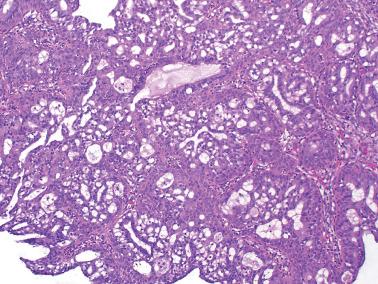
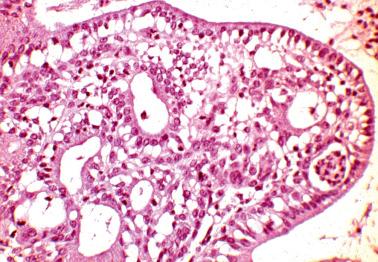
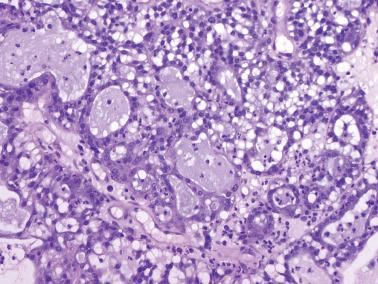
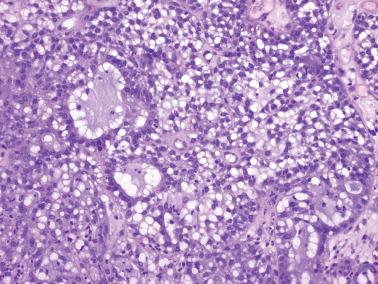
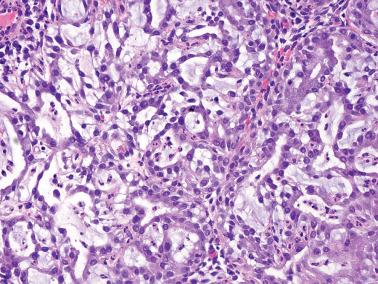
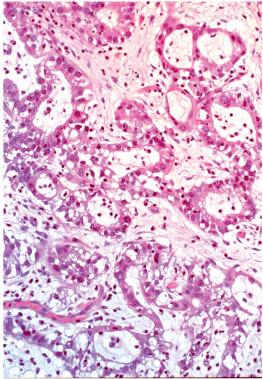
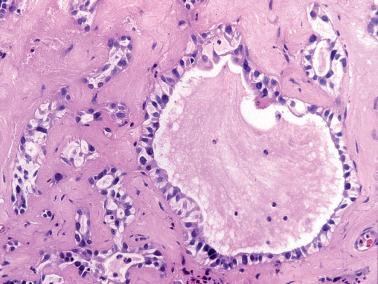
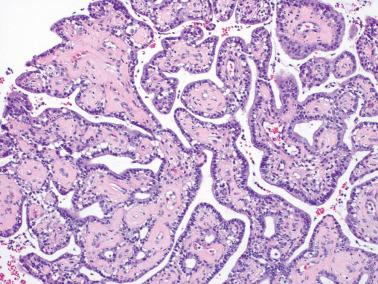
This rare incidental microscopic finding is characterized by a band-like proliferation of closely packed endocervical glands that is sharply circumscribed from the underlying stroma.
The usually normally sized glands are lined by endocervical columnar cells, sometimes with mild reactive cytologic atypia. Marked stromal chronic inflammation is common.
Distinguishing features from MDA ( Chapter 6 ) include a sharply circumscribed border, absence of invasion, and lack of focally malignant cytologic features and desmoplastic stroma.
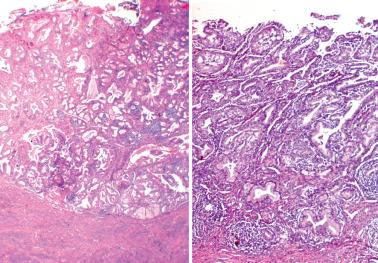
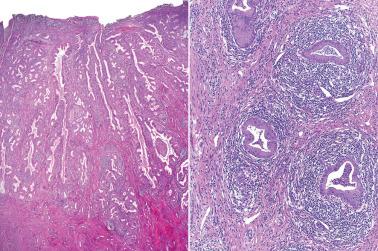
This rare lesion, which some investigators refer to as pyloric metaplasia (see below), is usually an incidental microscopic finding in the reproductive and postmenopausal age groups. Less commonly, there is a mucoid or watery discharge, abnormal glandular cells on Pap smear, or a gross abnormality that may include cysts. An occasional association with Peutz–Jeghers syndrome and rarely with peritoneal pigmentation has been reported.
LEGH is usually a well-demarcated lesion occurring most commonly in the superior part of the cervix close to the internal os. It typically occupies the inner-half of the cervical wall, although rarely may extend more deeply.
Most or all of the cervical mucosa is involved by predominantly lobular proliferations of small to moderate-sized glands that often surround a large gland. Tightly packed small glands may result in a pseudocribriform appearance.
The glands are typically lined by benign-appearing endocervical columnar mucinous cells with basal nuclei, although the cells may be larger than usual with copious cytoplasm. Occasional findings include intraglandular bridging (including a cribriform pattern), intestinal metaplasia, focal mild atypia, and rare mitotic figures. Thin periglandular cuffs of fibroblasts are often present.
A pyloric gland immunophenotype is typical, with positivity for HIK1083, MUC6, M-GGMC-1, TFF1, TFF2, and PDX1. PAX2 is also typically positive (see Differential Diagnosis ). ER and PR are typically absent in contrast to nonspecific endocervical glandular hyperplasias. Scattered chromogranin+/synaptophysin+ neuroendocrine cells and focal p16 staining may be present. HPV has not been found.
Japanese investigators have suggested that some LEGHs are premalignant or represent gastric-type AIS as they may precede gastric-type endocervical mucinous adenocarcinomas (GTAs), including minimal deviation adenocarcinomas (MDAs) ( Chapter 6 ).
Kondo et al., Nara et al., and Tsuji et al. found LEGH associated with in situ or invasive endocervical mucinous adenocarcinomas.
have described atypical LEGH (epithelial infolding, papillae, nuclear atypia, mitoses) associated with 30% of MDAs.
Kawauchi et al. found that atypical LEGHs exhibited chromosomal imbalances matching those in cervical mucinous adenocarcinomas, including MDAs and other GTAs.
Takatsu et al., using clonality and mutational analyses of the STK11 gene (mutations of which occur in MDA), found that a subset of MDA-associated LEGHs were monoclonal, suggesting that a STK11 mutation may be involved in the progression of LEGH to MDA.
Matsubara et al. found mutations in 11 of 19 cases of LEGH: GNAS (8), STK11 (2), and KRAS (1), as well as GNAS mutations in 5% of endocervical-type mucinous adenocarcinomas. They concluded that LEGH is likely neoplastic rather than hyperplastic.
Asaka et al. found that immunostaining for trefoil factor family 2 protein (TTF2) and gastric mucin α1,4-linked N-acetylglucosamine residues (αGlcNAc-R) was present in the cytoplasm and luminal secretions of LEGH, AIS, and invasive adenocarcinomas but not in normal glands.
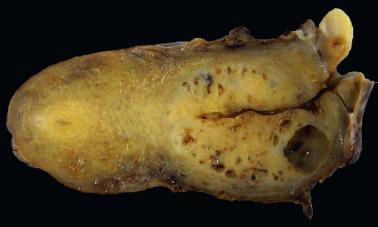
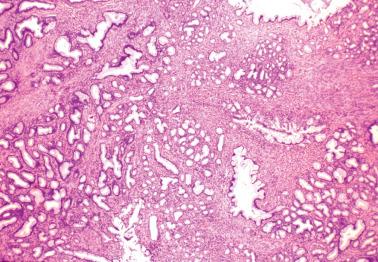
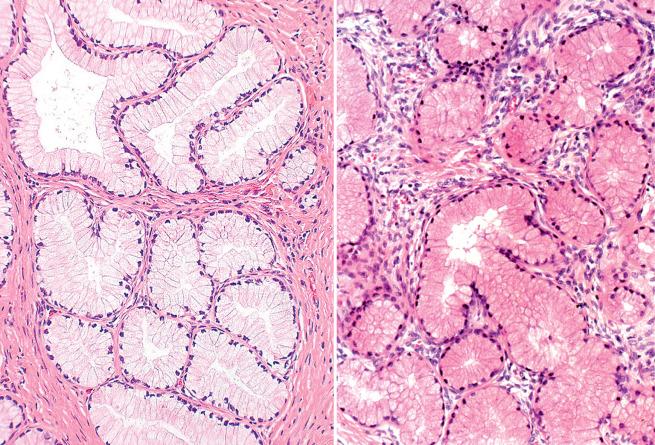
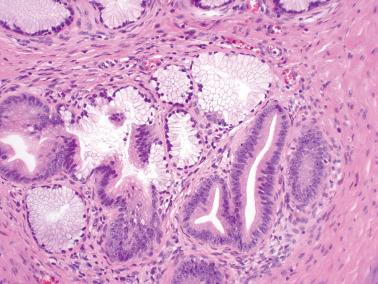
Tunnel clusters (TCs). This very common, probably involutional, finding (see separate heading) consists of well-circumscribed clusters of glands with flattened or low cuboidal cells, lacking the hyperplastic appearance and tall cells of LEGH. The glands of TCs, in contrast to those of LEGH, are confined to tight clusters, are usually more uniform in size and shape, and often contain inspissated mucin.
Minimal deviation adenocarcinoma (MDA). Typical LEGH differs from MDA ( Chapter 6 ) by its superficial location, a predominantly lobular pattern, no more than mild atypia and rare mitoses, absent desmoplasia, and strong diffuse nuclear reactivity for PAX2.
Previs et al. reported a case of a florid endocervical glandular proliferation presenting as a mass in a 24-year-old woman with cystic fibrosis who used OCs. Although initially interpreted as well-differentiated adenocarcinoma, its circumscription, bland cytology, mitotic inactivity, and acute inflammation favored a hyperplastic process.
A similar or identical lesion was reported by Dooley et al. as ‘polypoid cervicitis’ in women with cystic fibrosis who were using OCs.
This designation is appropriate for occasional examples of endocervical glandular hyperplasia that lack the specific features of the foregoing subtypes but that are clearly benign based on their architecture and bland cytology.
Within this group are rare cases characterized by a congerie of glands with benign characteristics based on their overall architectural and cytologic features. In some such cases the cells have pale to clear cytoplasm with a distinctive central location of the nucleus. This nuclear position can occasionally be seen in nonhyperplastic endocervical glands but is more striking in the hyperplastic cases.
We have also seen rare cases in which there is a band-like proliferation of endocervical glands separated by fibromatous stroma imparting an adenofibromatous appearance.
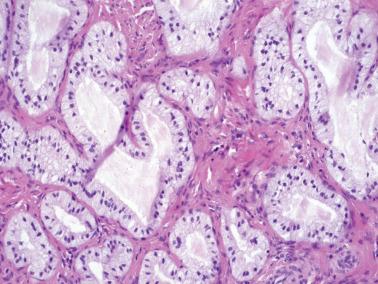
This rare lesion is usually an incidental microscopic finding in the reproductive and postmenopausal eras. Some examples have been associated with an adenoid basal carcinoma (ABC) ( Chapter 6 ).
Bud-like proliferations of cells with bland nuclear features arise in the area of the squamocolumnar junction in continuity with subcolumnar reserve cells with which they share the same morphology and immunoprofile (Kerdraon et al.).
The buds project into the adjacent stroma or form detached nests. Gland-like spaces may be seen in some of the buds and nests; squamous differentiation is rare. There is no stromal reaction and the overlying epithelium appears normal or mildly atypical.
This lesion may be confused with an ABC but differs from the latter in its tiny size, superficial location, and usual absence of: dysplasia, squamous differentiation, mitotic activity, and p16 staining.
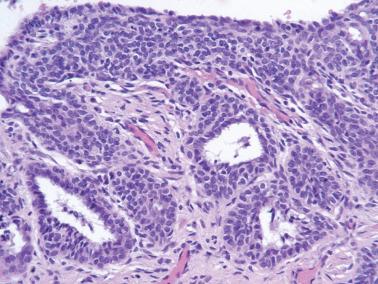
Mesonephric remnants, which occur in the walls of the cervix in up to 10% of women, are an incidental microscopic finding in reproductive and postmenopausal age groups. Rarely there is an abnormal Pap smear. A few vaginal cases have also been reported.
Microscopic examination reveals one to several small, well-circumscribed lobular aggregates of usually small mesonephric tubules, sometimes with a central duct. The cells lining the tubules lack atypia and mitotic activity.
The most specific marker is GATA3 (nuclear staining), although the staining intensity and extent is quite variable. The apices of the cells and luminal contents are typically CD10+; the cytoplasm is p16+, a finding that can incorrectly suggest AIS.
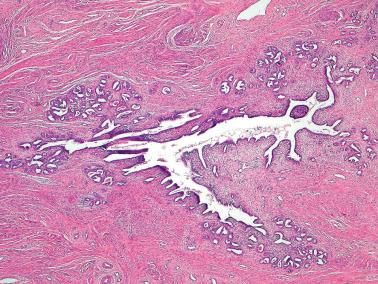

This lesion usually occurs in reproductive and postmenopausal age groups. It is almost always an incidental microscopic finding, but rarely causes induration, nodularity, an erosion, or an abnormal Pap smear.
Remnants of the mesonephric duct are present in some cases. The proliferation may extend to the overlying endocervical mucosa or margins of a cone biopsy specimen. Extension into the deep cervical stroma and/or the lower uterine segment may be seen in hysterectomy specimens.
Tubules in a lobular (80% of cases) or diffuse pattern range from small and uniform to variably sized and shaped and cystic. The tubules often contain a characteristic eosinophilic, colloid-like, PAS-positive luminal secretion. There is no stromal response.
The tubules and cysts are usually lined by a single layer of mucin-free cuboidal to flattened cells. The nuclei are usually uniform, but occasionally mildly atypical. Mitotic figures are rare or absent.
Unusual features include cellular stratification and bridging and tubules lined by columnar cells imparting a pseudoendometrioid appearance.
The most specific marker is GATA 3 (nuclear staining, see above). Other markers include PAX2 and PAX8 (strong nuclear), CD10 (apical cytoplasm and luminal secretions), and p16 (focal moderate to strong cytoplasmic). p16 reactivity may incorrectly suggest an invasive adenocarcinoma, but unlike most of the latter, nuclear staining is absent and only rare cells are MIB1+. Mirkovic et al. found that the KRAS/NRAS mutations seen in mesonephric carcinomas are absent in mesonephric hyperplasia.
The postoperative clinical course is uneventful, including cases in which the lesion extends to the resection margins. Rare mesonephric neoplasms ( Chapter 6 ), however, have been contiguous with mesonephric hyperplasia.
The differential diagnosis is with adenocarcinoma, especially mesonephric carcinoma (see corresponding heading in Chapter 6 ), MDA, CCC, and endometrial carcinoma.
Features favoring mesonephric hyperplasia over MDA include an absence of a mass, no mucosal involvement, mucin-free cytoplasm, absence of a periglandular stromal response, and a GATA3+/PAX2+/CEA − immunoprofile.
Features favoring or establishing a diagnosis of CCC over mesonephric hyperplasia include a mass, papillary and solid growth patterns, cells with clear glycogen-rich cytoplasm, hobnail cells, moderate to marked nuclear atypia, more than a rare mitotic figure, and a napsin+/GATA3 − immunoprofile.
Endometrial endometrioid carcinomas (EECs) with cervical involvement characterized by small tubular glands ( Chapter 8 ). Awareness of, and continuity with, a primary EEC and negative GATA3 staining facilitate the diagnosis. However, a subset of ER-negative endometrioid carcinomas have been shown to express GATA3, a potential pitfall in this category.
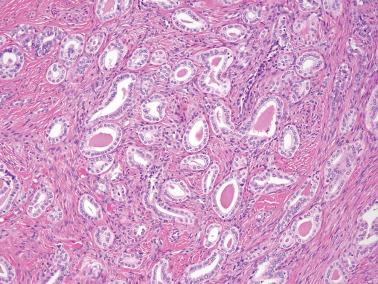
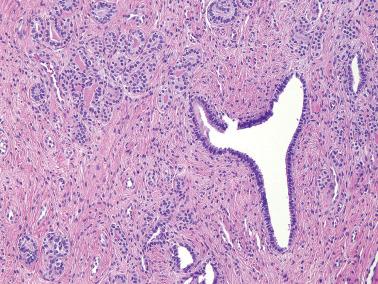
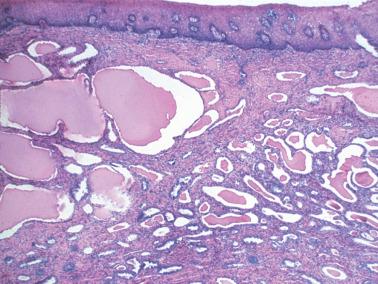
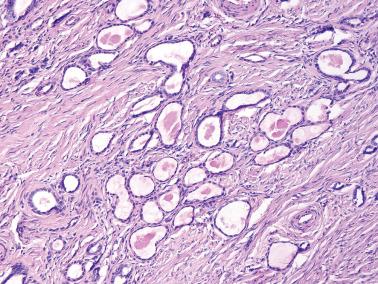
This finding, in which the mesonephric duct is lined by hyperplastic epithelium typically in the form of micropapillary tufts, is most commonly associated with usual mesonephric hyperplasia but rarely is an isolated finding.
Misdiagnosis as a premalignant or malignant glandular lesion may occur, particularly when it is an isolated finding. Features favoring mesonephric ductal hyperplasia include an elongated duct, micropapillae, an absence of nuclear atypia, lack of association with endocervical glands, and GATA3 staining.
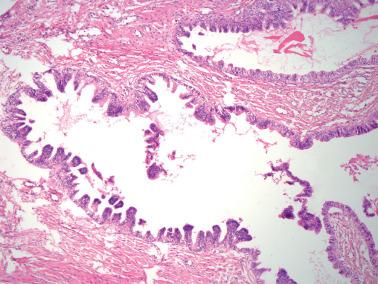

This finding is due to implantation of squamous epithelium at the time of a previous biopsy. It may be confused with squamous carcinoma because of a deep location, a lack of nearby endocervical glands, irregularity of the squamous nests, a granulation tissue-like and/or fibrotic stroma, and often a history of SIL in a previous biopsy
The correct diagnosis is suggested by the history of a previous biopsy, the presence of only one or a few nests, bland nuclear features, absence of abnormal epithelium between the deep nests and surface epithelium, and no nearby SIL.
An analogous finding is artifactual displacement of dysplastic squamous epithelium into vessels at the time of lidocaine injection prior to a LEEP.
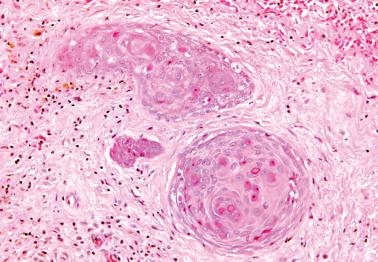
Squamous atypia ( Chapter 5 ).
Glandular atypia:
Reactive glandular atypia may occur in otherwise normal endocervical surface or glandular epithelium, metaplastic epithelium (such as tubal metaplasia), or the glands of non-neoplastic cervical lesions such as tunnel clusters. Such atypia may be related to unusual degrees of inflammation or follow an endocervical and/or endometrial curettage or radiation (see below).
The cells may be stratified and may have a micropapillary pattern. The cytoplasm can be mucin-depleted and slightly eosinophilic or squamoid. The nuclei are variable in size and shape and variably hyperchromatic with a smudgy appearance; hobnail-type cells may be present. Stromal fibrin, fibrosis, and inflammatory cells are often present.
Differences from AIS include interspersed normal cells; an absence or rarity of: severely atypical cells, mitotic figures, and apoptotic bodies; and associated mucosal denudation, fibrin, and/or fibrosis.
Pagetoid dyskeratosis:
This probably reactive lesion is characterized by pagetoid keratinocytes within the ectocervical epithelium. Val-Bernal et al. found it in 37% of hysterectomy specimens removed for prolapse; the corresponding figure for leiomyomatous uteri was only 5%.
Large round to polygonal cells with abundant pale eosinophilic cytoplasm and a central pyknotic nucleus surrounded by a clear halo are usually singly disposed among typical squamous cells in the suprabasal and mid-zones of the squamous epithelium.
The cells stain for high molecular weight cytokeratin (34β-E12) in contrast to the surrounding normal squamous cells, suggesting premature keratinization. Unlike Paget's disease (which can rarely involve the cervix), the cells lack atypia, are mucin-negative, and are negative for CAM 5.2, EMA, and CEA.
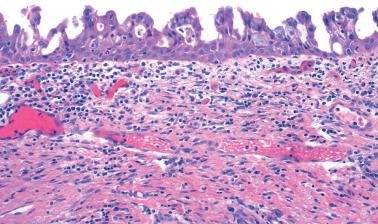
Atypia of squamous or endocervical glandular epithelium can be found weeks to years after radiation. Gross examination may occasionally show mucosal irregularity, fibrosis, induration, or stenosis.
Squamous and glandular cells have abundant cytoplasm and hyperchromatic nuclei of variable size and shape, but a low N/C ratio, uniform nuclear spacing, and smudged indistinct chromatin. Cellular degeneration, cytoplasmic vacuoles, and cell necrosis may be seen. Mitotic figures are typically absent.
Radiation changes in the stroma and blood vessels are common; radiation fibroblasts are uncommon.
Attention to the above features and knowledge of the history facilitate distinction from a premalignant change.
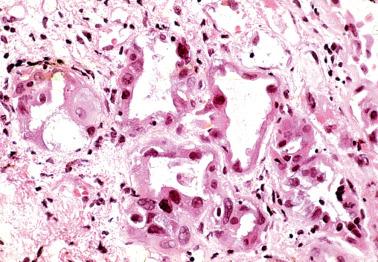
Mucin extravasation from a ruptured gland may result in periglandular edema and inflammatory cells, including foamy histiocytes and foreign-body-type giant cells. Rarely, the mucin is found within cervical lymphatics.
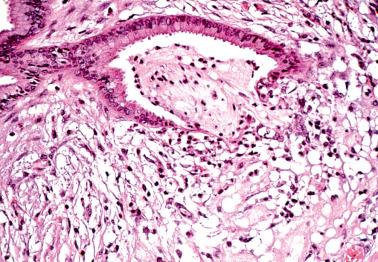
See Chapter 3 .
These granules ( Chapter 7 ) are an occasional incidental finding within the lumina of endocervical glands, where they are usually associated with inspissated mucus and/or inflammatory cells.
Microscopic examination of the cervical mucosa commonly reveals a variable number of chronic inflammatory cells, typically lymphocytes and plasma cells and occasional mast cells.
A small fragment of endocervical tissue containing plasma cells contaminating an endometrial specimen can be misinterpreted as chronic endometritis if its cervical origin is not appreciated.
Intravascular accumulation of nonatypical lymphocytes is a common finding, especially in cases of severe cervicitis (Karpathiou et al.).
This is usually an incidental microscopic finding of no clinical significance. Uniform stromal papillae containing chronic inflammatory cells are covered by a single layer of benign-appearing endocervical columnar epithelium.
A lack of cellular stratification and atypia facilitates distinction from villoglandular adenocarcinoma.
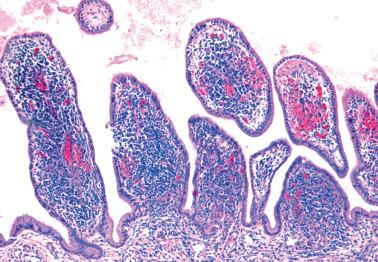
This designation refers to inflammation of the endocervical mucosa with numerous subepithelial and periglandular lymphoid follicles, often with germinal centers. Some cases may be due to chlamydial infection, which can be confirmed with culture or immunohistochemical staining.
Other frequent findings include a marked periglandular plasmacellular infiltrate, neutrophilic infiltration of the columnar epithelium, and stromal lymphocytes and histiocytes. The surface epithelium may be lost, but the deep necrotic ulcers of herpetic cervicitis are absent.
Distinguishing features from nodular lymphoma include an absence of a mass, the presence of follicles with germinal centers, and a mixed inflammatory infiltrate.
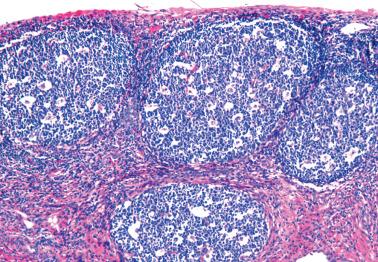
This process is typically encountered in the cervix in women of reproductive age. Some cases have been associated with viral infection (infectious mononucleosis, CMV, EBV) or a previous LEEP.
There is frequently an abnormal gross appearance (occasionally with ulceration), but unlike cervical lymphoma, the cervix is not enlarged. Abnormal Pap smears in some cases may be due to a synchronous SIL.
Beneath an intact or eroded epithelium, a typically dense superficial band-like lymphoid infiltrate is composed predominantly of large lymphoid cells (including immunoblasts) with mitotic activity. Plasma cells and polymorphonuclear leukocytes are also usually present.
Immunohistochemical studies indicate an admixture of B and T cells without immunoglobulin light chain restriction. Some of the lesions are polyclonal, whereas others have had a clonal IGH gene rearrangement by PCR. A benign interpretation in such cases is supported by an absence of lymphoma on staging or follow-up.
Features of this lesion vs lymphoma include an admixture of different cell types and an absence of the following: a large mass, cervical enlargement, deep invasion, perivascular involvement, and sclerosis.
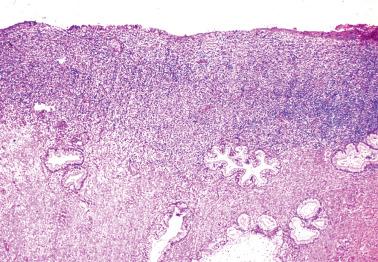
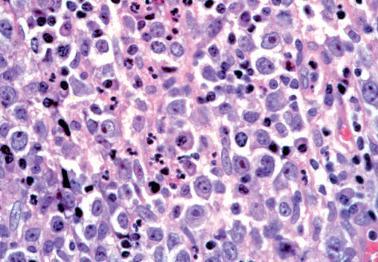
A dense plasma cell infiltrate in the endocervical stroma and within the stroma of endocervical polyps is a common incidental microscopic finding; numerous Russell bodies may be present. In rare cases, the process has simulated a carcinoma on clinical examination.
As with typical endocervicitis, if a fragment of cervix with plasma cell cervicitis contaminates an endometrial sample, it can be misinterpreted as chronic endometritis if the cervical origin of the tissue is not appreciated. Rarely, plasma cell cervicitis may be mistaken for multiple myeloma on cytologic or histologic examination.
Become a Clinical Tree membership for Full access and enjoy Unlimited articles
If you are a member. Log in here